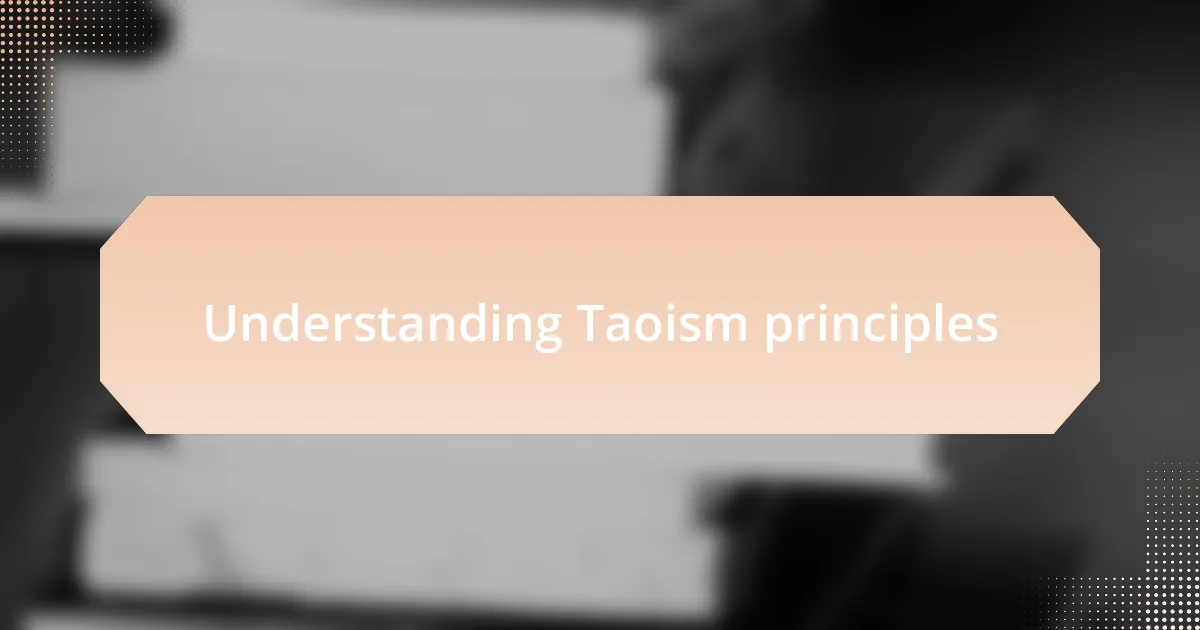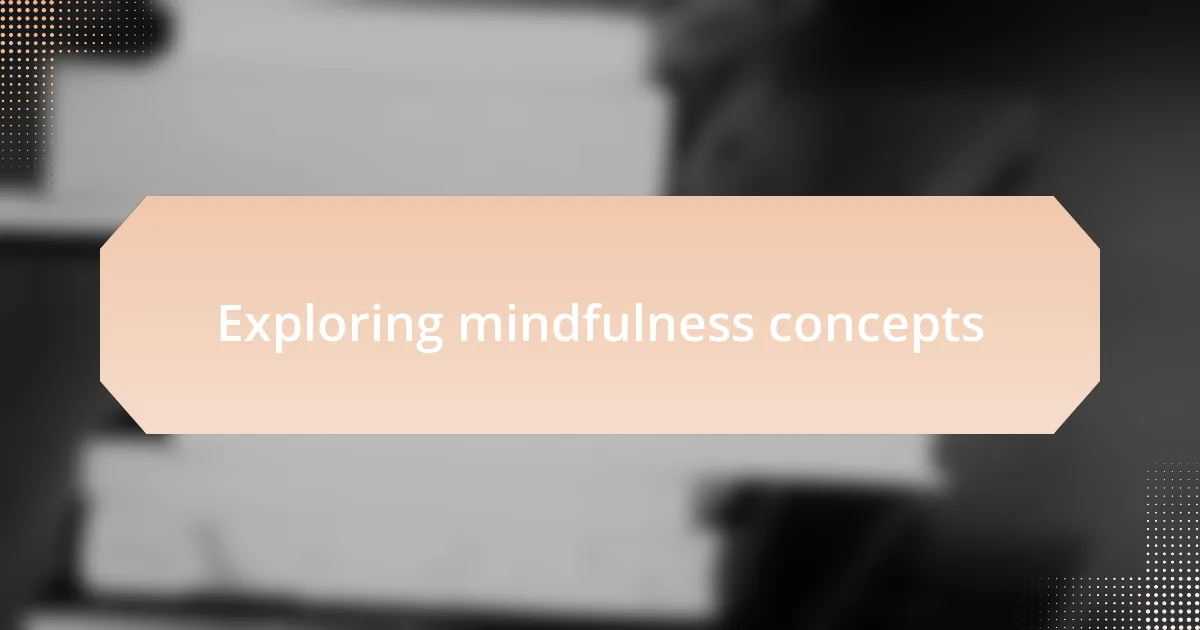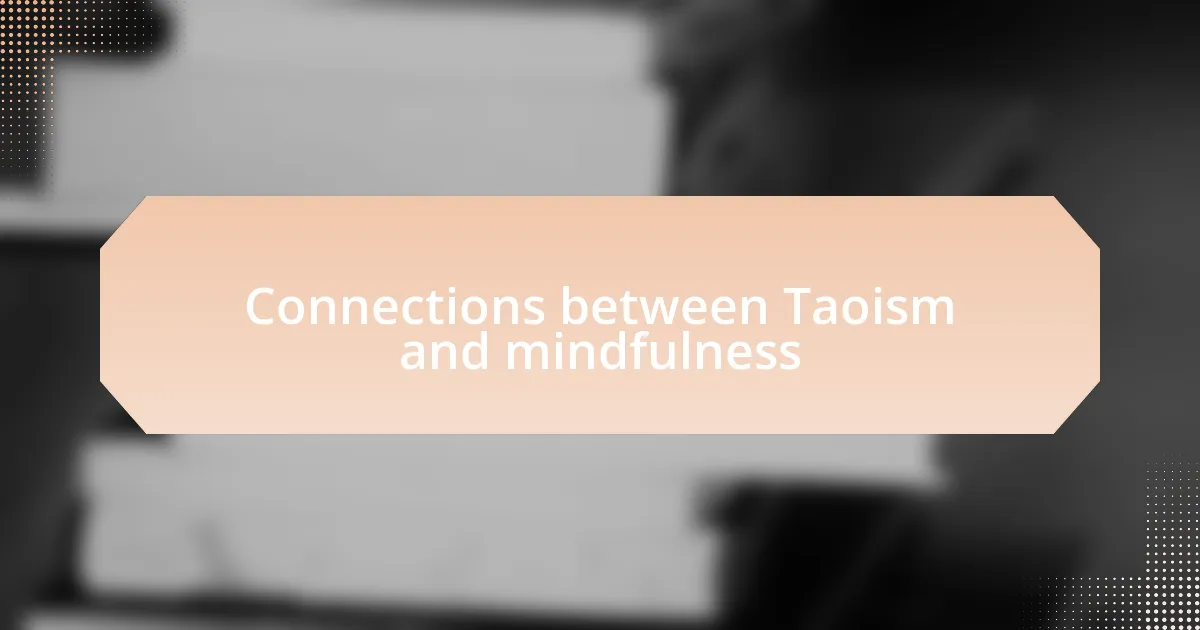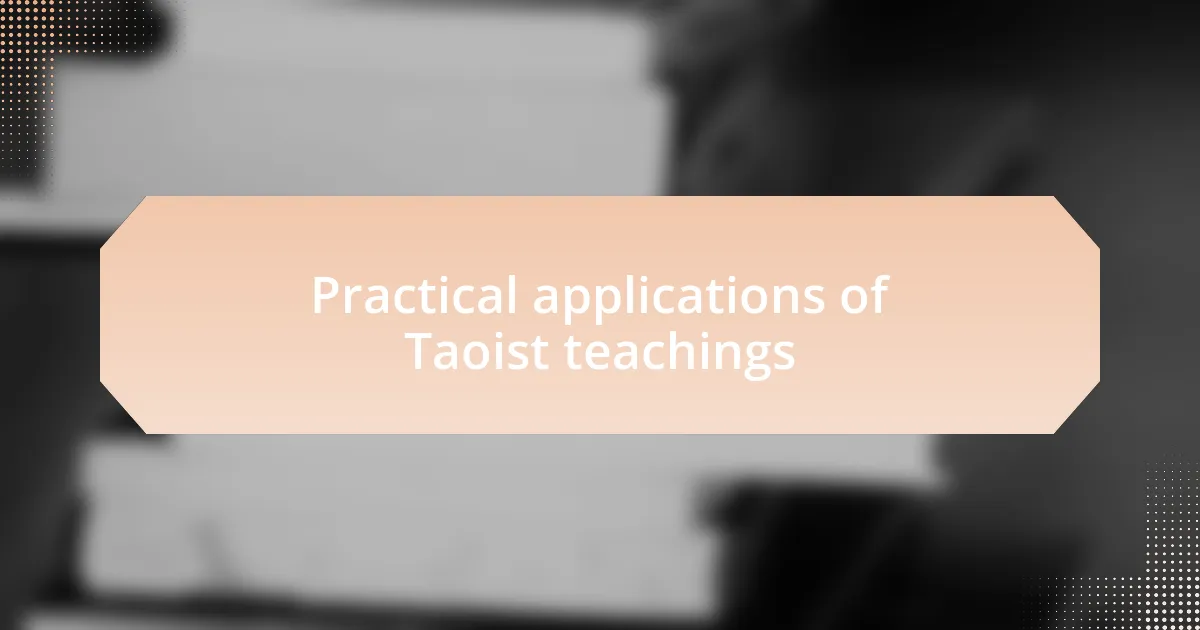Key takeaways:
- Taoism emphasizes living in harmony with the Tao, highlighting principles like “wu wei” or effortless action, which advocates non-resistance to life’s challenges.
- The concepts of balance and simplicity are central, encouraging a mindful approach to life that fosters peace and clarity amidst chaos.
- Mindfulness, closely linked to Taoism, involves being fully present and appreciating the interconnectedness with nature and others, enhancing overall well-being.
- Integrating Taoist principles into daily routines, such as practicing stillness, embracing nature, and nurturing calm communication, can lead to a more harmonious life.

Understanding Taoism principles
Taoism, at its core, emphasizes living in harmony with the Tao, or the Way, which offers a profound perspective on existence. I remember the first time I stumbled upon the concept of “wu wei,” or effortless action. It struck me that sometimes, the best way to deal with life’s challenges is not through forcefulness but by allowing things to unfold naturally. Isn’t it liberating to think that we don’t always have to struggle against the tide?
One of the most beautiful teachings I’ve encountered is the importance of balance. Taoism teaches that Yin and Yang are complementary forces, and I often reflect on how this principle mirrors the ups and downs of everyday life. For instance, when facing stress, I recall the need to embrace both work and rest, both light and dark. Have you ever noticed how moments of stillness can lead to clarity?
As I’ve delved deeper into Taoism, I’ve found the idea of simplicity to be transformative. The notion that true wisdom lies in the simplicity of living resonated with me during a chaotic time in my life. I started to declutter my environment and simplify my thoughts, which led to unexpected peace. Isn’t it interesting how reducing what feels overwhelming can unveil what truly matters?

Exploring mindfulness concepts
Exploring mindfulness in the context of Taoism reveals some intriguing concepts that speak to the essence of living in the moment. I often reflect on how the practice of mindfulness encourages us to fully engage with our surroundings, much like the Taoist principle of being present and aware. For me, adopting this mindset has transformed mundane activities into sources of joy. Have you ever sat quietly, noticing the rustle of leaves or the gentle flow of water, and found a moment of peace in that stillness?
In my experiences, I’ve discovered that mindfulness is not merely about sitting in silence; it’s about embracing each moment without judgment. I remember a time when I was overwhelmed with responsibilities and felt like I was on a hamster wheel. It was during a quiet walk in nature that I learned to pause and breathe deeply, allowing my thoughts to settle. This practice of being fully present not only calmed my mind but also enhanced my appreciation for the little things. How often do we rush through life and miss the beauty right in front of us?
Furthermore, a unique aspect of mindfulness linked to Taoism is the acknowledgment of our interconnectedness with nature. On one occasion, while meditating in a tranquil garden, I felt a profound sense of unity with my surroundings. It was an eye-opening moment that reminded me of how we are part of something much larger. Isn’t it fascinating how immersing ourselves in nature can not only ground us but also foster a deeper understanding of our existence?

Connections between Taoism and mindfulness
The connection between Taoism and mindfulness is deeply rooted in the practice of stillness and presence. I recall a serene moment spent by a quiet pond, where the water mirrored the sky perfectly. In that stillness, I felt as if I was channeling the Taoist idea of harmony with nature, where every ripple mirrored my thoughts, teaching me to embrace tranquility. Isn’t it remarkable how such experiences can guide us toward a more mindful existence?
Taoism emphasizes the concept of “wu wei,” or effortless action, which resonates deeply with mindfulness. One afternoon, I decided to let go of my rigid agenda and flow with my surroundings; rather than forcing productivity, I simply engaged with what was at hand. This approach opened my eyes to the beauty of spontaneity, reminding me that sometimes doing less allows us to enjoy life more fully. How often do we forget that stillness can be a sign of strength rather than inactivity?
Moreover, both practices encourage a gentle acceptance of life’s ebb and flow. I remember facing a challenging situation that tested my patience. Instead of resisting, I chose to acknowledge my feelings and let them pass, much like the Taoist teaching of aligning with the natural order. That shift in perspective not only eased my stress but also awakened a sense of gratitude for the journey itself. Would you agree that embracing life’s uncertainties can ultimately lead to greater peace?

Practical applications of Taoist teachings
Practically applying Taoist teachings often starts with incorporating mindfulness into daily life through simple rituals. I remember one winter afternoon, I took a walk in the park, focusing solely on each step and the sensation of the cold breeze against my skin. It was in that moment of mindful walking that I truly understood the Taoist principle of being present—each breath and each contact with the earth felt like a reminder of my connection to the world around me. Have you ever felt that incredible feeling of being “in the moment”?
Another practical application is cultivating a mindset of acceptance through reflection. I once found myself frustrated over unmet expectations during a group project at work. Instead of wrestling with my emotions, I took a quiet moment to reflect, reminding myself of the Taoist teaching to embrace impermanence. This shift allowed me to engage more openly with my team and find beauty in our collective adaptability. How often do we miss that opportunity to transform stress into growth?
Additionally, practicing mindfulness through gratitude can be a practical manifestation of Taoist teachings. I recall an evening when I sat alone with my journal, listing out moments of gratitude from the day. This practice not only filled my heart with joy but also aligned me with the Taoist belief in the interconnectedness of all things. Have you ever noticed how acknowledging small blessings can dramatically shift your mindset and enrich your experience?

Personal experiences with Taoism
Taoism has a way of quietly weaving itself into the fabric of everyday experiences. One afternoon, I found myself sitting by a flowing river, mesmerized by the way the water effortlessly navigated around rocks and bends. In that moment, I realized that this fluidity embodied the Taoist teaching of “wu wei” or effortless action—reminding me that sometimes, the best way to approach challenges is to flow with them rather than resist. Have you ever felt the release that comes from letting go?
Reflecting on my journey with Taoism, there was a time when I felt overwhelmed by the chaos of life’s demands. I decided to incorporate Tai Chi into my routine. As I moved through its gentle, flowing movements, I felt a deep sense of calm wash over me. It was like flipping a switch in my mind, allowing fears and stress to dissipate. This practice deeply resonated with me, showing how embracing stillness can serve as a refuge in the storm of daily life. How often do we forget to simply breathe and find our center?
One evening, I had a profound realization while stargazing with a friend. As we shared our thoughts under the vastness of the universe, I felt a deep sense of connection to something greater. This experience encapsulated the Taoist view of interconnectedness; it was as if the stars were whispering ancient truths to us. I learned that acknowledging our place in this grand design brings a sense of peace and clarity that shapes our journey. Have you experienced that enlightening moment when everything feels perfectly aligned?

Integrating Taoism into daily life
Finding ways to integrate Taoism into daily life often starts with simple practices that invite mindfulness. For instance, I began my mornings with a dedicated moment of stillness, just a few minutes of observing my breath. This act of pausing transformed my rushed mornings into sacred moments, allowing me to set a peaceful tone for the day ahead. Have you ever considered how a small change in your routine could alter your entire outlook?
I also started to embrace nature more consciously during my daily walks. Instead of rushing through my surroundings, I began to immerse myself in the experience—feeling the breeze, listening to the rustle of leaves, and watching how each element of nature coexists. This connects deeply with the Taoist idea of living in harmony with the environment. It’s remarkable how just being present in nature reminds us of our place within the greater whole. When was the last time you truly savored the world around you?
Additionally, I found value in incorporating Taoist principles into my interactions with others. When faced with conflict, I practiced patience and sought understanding rather than reacting impulsively. This shift allowed me to confront disagreements with a sense of calm and clarity, reflecting the Taoist belief in harmony and balance in relationships. How has a mindful approach to communication changed your interactions?